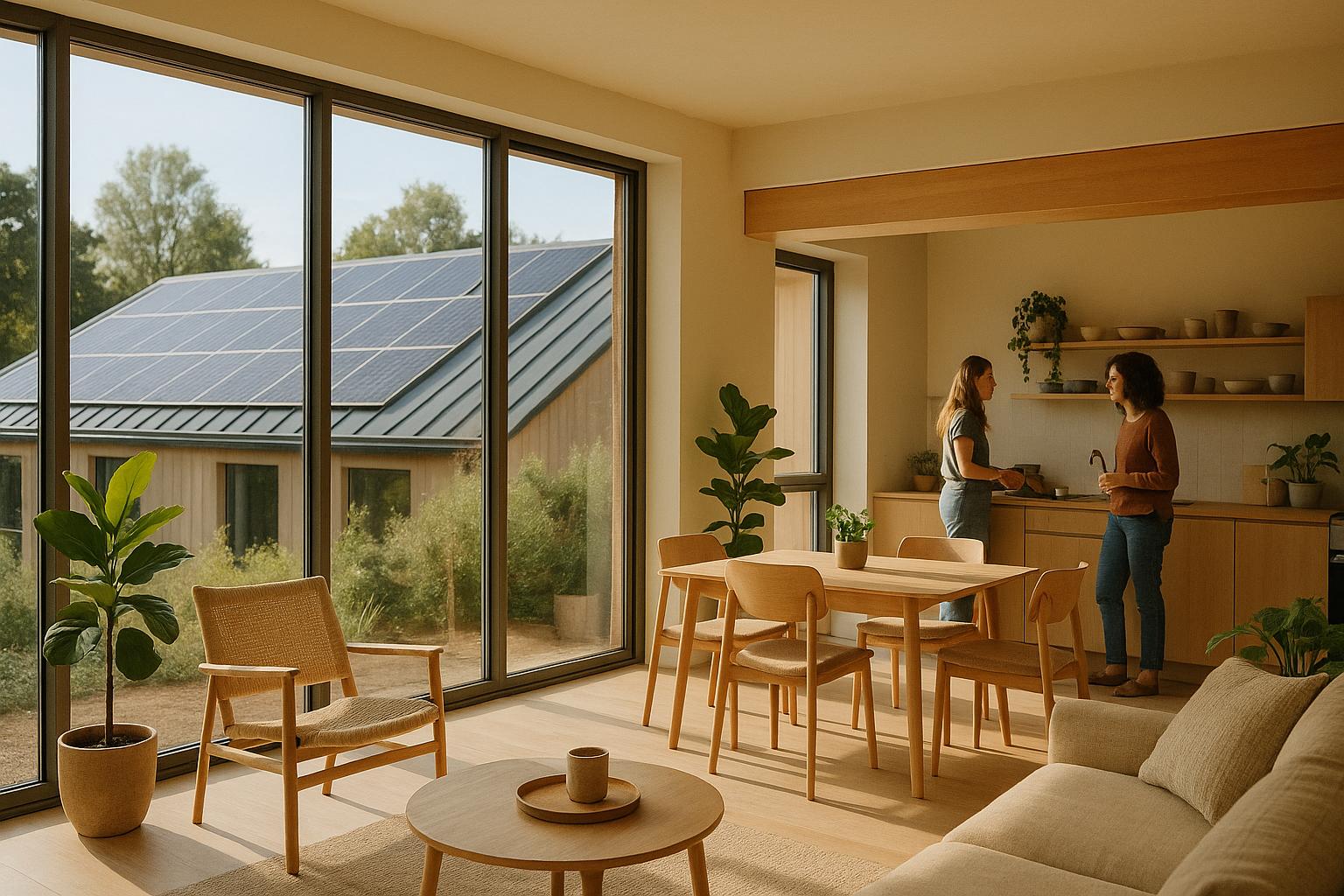Coliving and coworking are reshaping how professionals live and work.
- Coliving offers private bedrooms with shared spaces, utilities, and Wi-Fi, starting at $100/month in 380+ cities. It’s ideal for remote workers and digital nomads seeking flexibility and community.
- Coworking provides shared office spaces with desks, meeting rooms, and networking opportunities, starting at $150/month. It’s great for freelancers and entrepreneurs needing a productive environment.
- Combined coliving-coworking spaces merge the two, offering private living quarters and professional workspaces under one roof for added convenience and community.
Each option serves different needs: coliving for affordable housing, coworking for professional productivity, and combined spaces for an all-in-one solution. While combined spaces are convenient, they’re often pricier and limited to major cities. Choose based on your priorities - community, cost, or convenience.
1. Standalone Coliving
Standalone coliving spaces focus on creating a comfortable and community-driven living experience, keeping work and home life distinctly separate. These setups are perfect for those who prefer clear boundaries between work and relaxation.
Amenities and Services
These coliving spaces typically include fully furnished private bedrooms alongside shared spaces like kitchens and living rooms. Utilities, high-speed internet, cleaning services, and basic supplies are often bundled into the arrangement.
Beyond the essentials, many standalone coliving spaces prioritize lifestyle perks. Think fitness centers, game rooms, and leisure areas. Some even go the extra mile with concierge services or regular social events to build a lively and engaging community.
Flexibility and Mobility
One standout feature of standalone coliving is the flexible leasing options. Instead of committing to long-term contracts, residents can often choose shorter leases. This is especially appealing for people who value mobility - whether they’re chasing new job opportunities or adjusting to personal changes.
Community and Networking
Shared spaces and community events naturally encourage interaction, making it easy to form connections. These spaces create an environment where friendships can flourish, and cultural exchanges happen organically. This sense of camaraderie enriches the overall living experience.
Cost Efficiency
In bustling urban areas, standalone coliving can be a cost-effective choice, bundling rent with utilities, internet, and cleaning services into one manageable payment. However, keep in mind that dedicated workspaces, if needed, usually come with an additional fee.
2. Standalone Coworking
While coliving focuses on solving housing challenges, coworking caters to the need for a dedicated, professional workspace.
Standalone coworking spaces provide a polished work environment for individuals who want a clear separation between their home and work life.
Amenities and Services
These coworking spaces are designed to offer top-notch work facilities, including high-speed internet, printers, and meeting rooms. Members can choose from hot desks, dedicated desks, or private offices, depending on their preferences and privacy needs.
To enhance the experience, many locations include phone booths, fully-equipped conference rooms, and kitchen areas stocked with complimentary coffee and snacks. Some high-end spaces go a step further, offering wellness rooms, podcast studios, and even childcare services during working hours.
Flexibility and Mobility
Coworking memberships are highly adaptable, with options for day passes, monthly plans, or annual subscriptions. Many coworking networks grant access to multiple locations, making it easy for digital nomads or traveling professionals to maintain a consistent workspace no matter where they are.
Members also have the freedom to switch between hot desks and dedicated spaces, scaling up or down based on their daily requirements and budget. This flexible setup not only accommodates changing needs but also fosters a dynamic atmosphere, encouraging networking and collaboration.
Community and Networking
Standalone coworking spaces naturally bring together professionals from a variety of industries, creating fertile ground for networking and collaboration. Entrepreneurs, freelancers, remote workers, and small business owners often find these spaces ideal for building connections.
Beyond casual interactions, many coworking spaces organize networking events, workshops, and skill-sharing sessions to promote professional growth. Some even offer structured programs like mentorship opportunities or formal networking groups, which can lead to business partnerships or career advancements.
Cost Efficiency
For professionals seeking a dedicated workspace, coworking often proves to be more budget-friendly than leasing a traditional office. Memberships typically range from $150 to $500 per month and cover essentials like utilities, Wi-Fi, and maintenance.
The all-inclusive pricing often includes perks such as coffee, printing credits, and access to meeting rooms, providing predictable costs. This setup is especially appealing to freelancers and small businesses looking to manage their overhead without the burden of maintaining a private office.
3. Combined Coliving-Coworking Spaces
Integrated coliving-coworking spaces take the best of both worlds - living and working - and bring them together under one roof. With the rise of remote work, these spaces cater to the needs of modern professionals by creating environments where transitioning between work and relaxation is effortless.
At their core, these spaces provide private living quarters paired with professional workspaces, blending the coziness of home with the focus needed for productivity.
Amenities and Services
These spaces are designed to make life easier. They offer private rooms, shared work areas, and conveniences like utilities, cleaning services, and community events - all wrapped into one package. What sets them apart is how seamlessly they combine personal and professional spaces, allowing residents to shift between the two without ever leaving the building.
Flexibility and Mobility
With flexible lease terms and an all-in-one pricing structure, managing costs becomes straightforward. This setup is perfect for those with dynamic work or travel schedules. Plus, by cutting out the daily commute, professionals can save time and enjoy a better balance between work and life.
Community and Networking
The integration of living and working spaces also amplifies the sense of community. Shared areas naturally bring people together, encouraging networking and fostering spontaneous collaboration among residents. It's a setup that not only supports productivity but also builds meaningful connections.
Advantages and Disadvantages
Each option comes with its own set of perks and challenges, depending on what you're looking for.
Standalone coliving is great for building tight-knit communities and finding budget-friendly housing. However, it comes with a trade-off - you’ll need to find and manage separate workspaces, which can add to your to-do list.
Standalone coworking, on the other hand, is all about boosting productivity and expanding your professional network. But it’s not without its downsides - you’ll have to juggle separate contracts for housing and workspace, which can feel like a hassle.
Now, if you’re looking to combine the best of both worlds, integrated coliving-coworking spaces might be the answer. These setups streamline everything by bundling rent, utilities, and workspace into a single package. They’re convenient and foster a hybrid community of professionals. The catch? They tend to be pricier and are often limited to specific urban locations.
It’s also worth noting that standalone coliving options are usually spread across a variety of neighborhoods, while coworking and integrated spaces are mostly concentrated in major cities.
Ultimately, the right choice depends on what matters most to you - community, convenience, or keeping costs low.
Conclusion
Your choice ultimately depends on your priorities and lifestyle. Each option brings its own advantages, catering to professionals at different stages of their careers.
Standalone coliving focuses on building a sense of community and keeping costs manageable, making it ideal for those who already have a workspace. Standalone coworking, on the other hand, is perfect if you need a dedicated place to focus and get things done. Meanwhile, integrated coliving-coworking spaces combine home and office into a single, seamless experience.
These integrated spaces offer unmatched convenience by blending your living and working environments. While they might come with a higher price tag in major cities, they save you the hassle of juggling multiple contracts or dealing with daily commutes. Plus, they create an atmosphere where personal and professional connections thrive under one roof.
With everything from rent to Wi-Fi included in one simple package, you can direct your energy toward what really matters: your work and the relationships you build along the way. This model reflects the growing trend toward a more connected and flexible way of balancing work and life.
If you’re ready to explore your options, Coliving.com offers access to over 1,900 coliving spaces in 380 cities around the world, with prices starting as low as $100 per month. Whether you decide on a standalone setup or an integrated space, the goal is to find an environment that supports your career ambitions while nurturing your well-being.
The way we work is evolving, and combining coliving with coworking is becoming a natural step forward in adapting to this new, dynamic lifestyle.
FAQs
What’s the difference between coliving spaces, coworking spaces, and combined coliving-coworking spaces?
Coliving spaces are all about shared living arrangements. They typically include communal amenities and are designed to encourage social interactions, often paired with flexible lease options. Coworking spaces, in contrast, focus on creating shared environments for work, offering features like desks, meeting rooms, and collaborative areas aimed at boosting productivity.
Now, imagine combining the two - coliving-coworking spaces do just that. These hybrid setups merge living and working environments seamlessly. Residents get fully furnished living spaces alongside dedicated work areas, making them a perfect choice for remote workers and digital nomads looking for convenience, community, and a lifestyle that balances work and leisure.
How do coliving-coworking spaces create better opportunities for community and networking compared to standalone options?
Coliving-coworking spaces merge shared living and working environments, creating natural opportunities for people to connect. With communal work areas, shared living spaces, and organized activities like workshops or social events, these spaces make networking a part of daily life.
What sets these integrated spaces apart from standalone alternatives is how effortlessly they blend personal and professional interactions. This setup encourages collaboration, sparks mentorship opportunities, and nurtures a sense of community, allowing individuals to thrive both socially and professionally.
What should I consider when deciding between standalone and combined coliving-coworking spaces in terms of cost and convenience?
When weighing standalone versus combined coliving-coworking spaces in the U.S., consider how integrated spaces simplify your life. These setups typically roll costs like rent, utilities, and coworking access into a single payment. Not only can this save you money, but it also spares you the hassle of juggling multiple bills. Plus, with everything in one place, you skip the commute, gain extra time, and enjoy the convenience of a built-in community.
Standalone options, however, might offer a lower base rent, but keep in mind you’ll need to budget separately for things like utilities or coworking memberships. They might also require more effort to access shared amenities or to build meaningful connections. If you’re looking for proximity, convenience, and a streamlined experience, integrated spaces often come out ahead as the more practical option.






